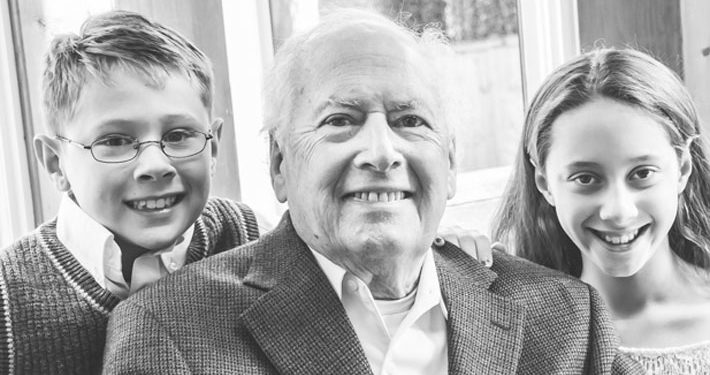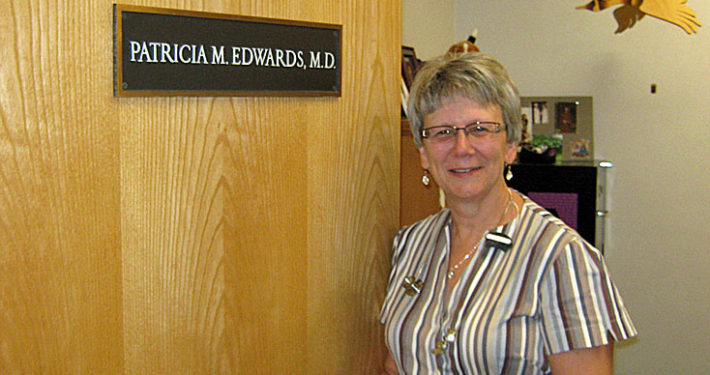Children who have health insurance, including Medicaid, are more likely to complete school, less likely to be in prison, and have higher lifetime earnings. As an investment, you can’t beat investing in children.Dr. Christoph Diasio
Why Medicaid Matters to Dr. Diasio
Medicaid plays a foundational role in the American health care system. For an informed perspective on Medicaid’s significance, look no further than Dr. Christoph Diasio. “Medicaid is this unbelievably deep and wide part of American society that people don’t appreciate,” says Dr. Diasio. “It supports much more than we realize.”
Dr. Diasio is a managing partner at Sandhills Pediatrics in North Carolina. A quick scan of his resume confirms his deep understanding of the relationship between Medicaid and providing quality care for children: Diasio sits on the board of the North Carolina Pediatric Society, the North Carolina state chapter of the AAP, and is a Co-Chair of the North Carolina Pediatric Council, a position that involves streamlining interactions between pediatricians and private insurance payers. Nationally, he is the Chair of the AAP’s Section on Practice Management (SOAPM), and participated as a member of the AAP’s Vision 2020 Task Force. Dr Diasio notes in this interview that he is not speaking on behalf of the AAP, NCPeds or any other organization.
Through his role with SOAPM, Diasio is able to speak fluidly about the importance of independent pediatrics for children, as well as Medicaid’s specific effects on independent practices. He’s interested in private practice, “because it enables me to do the things that I want to do,” says Dr. Diasio.
“If I want to have integrated mental health in my practice, or if I want to fund Reach Out and Read, or if I’m just tired of that laser printer on the corner and want to go buy a new one, being good at practice management gives you an ability to do those things.”
Diasio continues, “That’s the part about being independent that I relish. I don’t have to justify to someone in a suit why we choose to do what we do.” Dr. Diasio’s independent status aids him in his staunch advocacy for children. His perspective on the current Medicaid fight is rooted in the personal as well as the political, and he weaves together professional anecdotes with expansive knowledge of health policy. Further, SOAPM offers a space for practitioners to collaborate and explore ideas beyond beyond their specialties. “SOAPM has a very active listserv, so we end up talking about a lot of things that are far afield of pediatrics,” says Diasio. “We’re the place where a lot of community-based, independent pediatricians end up hanging out.”
Since its inception in 1965, Medicaid has positively impacted (and saved) the lives of an incredibly diverse patient community, from children with special needs to expecting mothers, and even elderly people in nursing homes. On this lesser-known allocation of funding, Diasio explains, “Medicare pays for doctors and drugs for older folks, but the actual service in the nursing home is covered by Medicaid. 60% of people in nursing homes have their care covered by Medicaid.”
This kind of coverage is only the tip of the Medicaid iceberg. 1 in 3 children in the U.S. are served by Medicaid, and the program provides assistance for almost 10 million parents. And yet, Medicaid continues to be severely threatened through the health care overhaul efforts of the Trump administration and a majority Republican house. Even following the collapse of the Better Care Reconciliation Act (BCRA), Medicaid’s future is still in doubt. Dr. Diasio offers his perspective on the fight for Medicaid, the current political climate, and his hopes for the future of children’s health in the U.S. His defense of Medicaid is first and foremost grounded in his work as a pediatrician: “Every single day I take care of children who would not have access to care without Medicaid,” says Diasio. “If you take 700 billion out of Medicaid over the next ten years, it is impossible to believe that these children will have the same access to healthcare.”
Exceptional Populations
Special needs families make up a population that wholly disproves the narrative of Medicaid-as-handout. “There’s a whole group of parents with children with special needs. For our really special kids, kids that are technologically dependent, who had major medical problems as children, their at-home nursing care is paid for by Medicaid, even if they have private insurance. It’s way cheaper to have at-home care for dependent children than to have them live out the rest of their lives in a hospital,” says Diasio. Indeed, a community of parents of children with complex needs have formed a group called Little Lobbyists, jumping with both feet into political activism in order to preserve their children’s Medicaid coverage, and thus their ability to live at home with their families.
“You want to see an advocate for a child? You’ve not seen anything until you see special needs parents. They are Jedis,” says Diasio.
Another oft overlooked Medicaid population is the foster care community. “Every foster child in America is covered by Medicaid,” says Diasio. “Let’s say you have private insurance and decide to foster a child—you can’t put that kid on your Blue Cross Blue Shield policy unless you actually adopt them. And getting through the adoption procedure can take years. If you’re in private practice and you have a client who feels called to be a foster parent, you won’t be able to see that child without Medicaid. Even if you’ll see them for free, if they then need additional therapies, they have medical problems, or even if the family is willing to pay out of pocket, for a lot of these things it’s just too expensive.”
Medicaid beneficiaries may also include children being cared for by their grandparents, in informal kinship relationships. “With the opiate crisis, we have more grandparents raising their grandchildren, and its Medicaid that’s covering their care,” says Diasio.
The bottom line? “Children who have health insurance who are covered by Medicaid are more likely to complete school, less likely to be in prison, have better lifetime earnings. As an investment, you can’t beat investing in children. Medicaid is an empowerment program. By having health insurance, by having their asthma treated so they can show up at school, so they can compete in sports, it provides kids with options they wouldn’t otherwise have. And it allows their parents to go to work, which improves the family’s overall economic status. There are real benefits that accrue to the rest of society when children have health coverage.”
A New Burden on States
Although the BCRA failed in July of 2017, Medicaid’s future still hangs in jeopardy. The Affordable Care Act (ACA) has survived the first year of the Trump administration, but Obama’s landmark healthcare policy is poised to take several blows under the new Republican tax bill, according to Politico. Specifically, the tax bill does away with the individual mandate, a component of the ACA that required most Americans to secure health insurance coverage, or else pay a fine.
“President Trump explicitly said during the election that he’s the only candidate who will guarantee that we don’t cut Medicare or Medicaid. Despite that, inside the BCRA was a huge whack to Medicaid,” explains Diasio. “His administration is going after it because it’s one of the big three items in the federal budget that you can move on. In my view, the three big buckets of money in the federal budget are Defense, Medicare, and Medicaid. And if you’re not going to cut the first two, Medicaid is your answer.”
While Diasio’s analysis is speculative, the narrative of the 2017 health care fight speaks to his accuracy. Since proponents of the BCRA attempted to pass the bill in the spring with little to no prior public visibility, the AAP was unable to perform any analysis to pinpoint specifically harmful components of the bill before it hit the Senate floor. Once it did, they found enormous proposed cuts to Medicaid, with predictions that the number of uninsured people in the U.S. would rise to from 29 million to 49 million people by 2026, according to the Congressional Budget Office.
37 million children are currently covered by Medicaid, while 8 million are covered by the Children’s Health Insurance Plan (CHIP), a program that works in conjunction with Medicaid in many states. (For more information on the close relationship between CHIP and Medicaid, check out the Georgetown Health Policy Institute blog.) Since Medicaid is a state and federal partnership, the federal government pays anywhere from 50-75% of the cost of health care for Medicaid patients. Ergo, in a state that funds Medicaid well, the federal government pays less than in a poor state.
“Because states share 25-50% of the cost, they have a huge motivation to save money on Medicaid. So the idea that states are out there being profligate and spending money willy-nilly because the federal government is on the hook is an absurd statement,” says Dr. Diasio. The AAP’s immediate past President, Dr. Fernando Stein, shares this position, and expands upon it in the AAP’s statement opposing the June Senate Health Care Bill. Dr. Stein writes, “This bill [the BCRA] would make a child’s access to health care dependent on his or her ZIP code and force states to make decisions about which vulnerable population gets services.”
Diasio elaborates: “Medicaid tries to create a base level of coverage that every child in America has access to. If you take money out of Medicaid, richer states might still have money to support Medicaid, and poorer states would not be able to do that. Cuts would hurt children disproportionately because most people on Medicaid in America are children. They’re not the biggest expense, but they are the largest population. Of course there are exceptions, but the number of children with high cost conditions compared to the number of children on Medicaid is relatively low. Most of the people on Medicaid are children, but most of the cost comes from care for adults.”
As states find it more and more challenging to provide adequate coverage for their Medicaid populations, children will lose out. In particular, children with exceptional health care requirements—such as children with special needs or pre-existing conditions—would suffer in the face of cuts, such as lifetime caps.
Caps, Cuts and Implosion: The ACA’s Shaky Future
From 2010-2014, Medicaid saw a 5.2% funding increase across the U.S. as a whole—but proposed lifetime caps could cause such expansion to plateau. “The reason caps are bad for children is because they limit the money that can be spent on Medicaid for each patient,” says Diasio. “This limits the increase in spending over time at a lower rate than Medicaid has historically increased spending, so there will be a net cut over time. Since the federal government can print money and the states can’t, the states will then have to raise taxes to provide the same level of Medicaid benefits, which most people think is unlikely.” Lifetime spending limits, also referred to as per capita caps, depend on the states’ contributions to Medicaid. With a spending cap, a child with a chronic illness or medically complex condition could suddenly lose coverage if they hit their lifetime limit. A child with cancer could be left uninsured.
Might it be more equitable to distribute funding per capita? Diasio explains: “Per capita caps may sound good, but let’s say you’re in a state that’s currently low-spending and efficient—you lose. Congratulations, you’ve done a good job, you’ll only get x amount per member. What if your state is overspending? You’re now fixed at that cap. Caps punish the states who are doing a good job.
Diasio continues, “Let’s say you’re in a state with a low per capita cap, and a miraculous drug comes out that improves outcomes for Cystic Fibrosis, but a patient who takes the drug will hit the spending cap as a result… what’re you going to do now? Do we just let these patients suffer? The per cap limit creates real problems for children.”
What about other kinds of proposed caps, such as block granting by state? “Block granting is even worse,” says Diasio. “The federal government would just drop a pile of money in each state capitol and say ‘Figure it out.’ The rules that are written on how states can use block grants are so lax that there are some analysts who think it could be used for building football stadiums and roads instead.” This concern is echoed by other healthcare experts. Elisabeth Wright Burbak of the Georgetown University Health Policy Institute writes, “Block grant proponents tout additional flexibility for states. In reality, a block grant ties state officials’ hands when Medicaid is needed the most: during economic downturns or unexpected population or health challenges that create additional need.”
Even if lifetime caps aren’t written into law, limits and cuts that may occur if the administration makes good on its promise to “let Obamacare implode,” would be devastating for children. Even if the ACA continues to stand as the nation’s official health care policy, the funding it allocates could dry up. Dr. Diasio explains: “The left-wing dream is Medicare for all. What actually passed [in the ACA] was a right-of-center plan. It’s all about the subsidies that the federal government pays the insurers. Letting the ACA die means that the federal government would stop making those payments. How long will insurers agree to let themselves hemorrhage if they don’t know whether they’re going to get paid?”
President Trump could sabotage the ACA by directing his staff to simply stop making payments to insurers. While the legality of this tactic is of course questionable, by the time such an issue makes it to court millions of people would have lost coverage. Such a move would, in Diasio’s words, “blow up the insurance market so quickly that the consequences of that decision would come back to the Trump administration immediately. It would be basically political suicide for them to do that.” However, it would appear that this catastrophic explosion may be imminent, with potential “political suicide” seemingly irrelevant those who would suffer it. In the final month of 2017, the Trump administration significantly decreased funding to organizations that assist with ACA enrollment (or “navigator” groups), and slashed the ACA’s advertising budget by 90%. This move will present serious roadblocks to obtaining insurance for the 2018 ACA enrollment period. “In total, funding for navigators will be reduced from $62.5 million for the 2017 enrollment to $36.8 million—a 41 percent drop,” reports Amy Goldstein of the Washington Post.
Continuing on the subject of funding cuts, Dr. Diasio argues, “Unless people wish for this to be Sparta, where we take the disabled children and leave them outside to die, we need Medicaid. But I think most people would agree that the Sparta position is well outside anything we’d wish for ourselves or our family members.”
Diasio offers the example of mother and nurse Ali Ranger, who advocated for Medicaid on social media by sharing the story of her three-year-old son, Ethan. Ranger discovered during her pregnancy that her son would be born with heterotaxy, a rare birth defect that required him to have multiple open heart surgeries and spend countless hours in the OR and CICU. For the most part, Ethan’s exorbitantly expensive medical bills have been covered by insurance. If lifetime caps were instated, it would be impossible for Ranger to meet her son’s complex health needs; just one of his surgeries costs a quarter of a million dollars. Ranger tweeted, “Without insurance we would owe $231,115 for 10 hours in the OR, 1 week in the CICU and 1 week on the cardiac floor… Nearly a quarter million dollars for one surgery. Reinstate lifetime caps and he’s out.” She continues, “Look my son in the eyes and tell him that he’s fought so hard to be here but sorry, you’re just not worth it anymore. I dare you.”
Children with rare conditions like Ethan’s may not be eligible for coverage under a new health care plan, as language around pre-existing conditions is still murky at best. In the AAP’s statement opposing the June iteration of the Senate Health Care Bill, then-acting President Dr. Fernando Stein addresses the plight of children with exceptional needs: “A ‘carve-out’ for some children determined to be ‘disabled’ does little to protect their coverage when the base program providing the coverage is stripped of its funding. Doing so forces states to chip away coverage in other ways, by not covering children living in poverty who do not have complex health conditions, or by scaling back the benefits that children and their families depend on.”
“The names of federal health care programs are themselves politicized. Medicare versus Medicaid: we care about old people but we aid poor people. It’s sort of a mnemonic value that undercuts assisting the poor.”Dr. Christoph Diasio
Dr. Stein’s comment draws attention to political semantics in the health care debate. Nonspecific promises, such as “carve-outs” and “protections,” can leave the general public confused or misinformed. In an interview with the New York Times, Andy Slavitt, former head of the Center for Medicare and Medicaid Services (CMS) under President Obama, comments, “Americans of all political stripes are getting exposed to both how challenging this is and how many layers of complexity the private-sector solutions bring to [health care.] There is a strong sentiment—even if it’s not a political one—to just simplify it.” This prevailing sentiment may ring all the more true as misinformation regarding the health care market makes its way through our political discourse.
“Medicaid is exploited in politics,” says Diasio. “The names of federal health care programs are themselves politicized. Medicare versus Medicaid: we care about old people but we aid poor people. It’s sort of a mnemonic value that undercuts assisting the poor. The public is told that folks on Medicaid are lazy people ‘living off the dole.’ Maybe those patients exist, but they’re not my patients. The vast plurality of people on Medicaid are hardworking people who have jobs that don’t pay much. Many parents of my Medicaid patients work two or three jobs to make ends meet, and they still qualify for Medicaid.” Walmart stores present a case study that proves the massive importance of Medicaid for low-wage workers. According to a 2014 report from Americans for Tax Fairness, Walmart employees nationwide required an estimated $6.2 billion in public assistance funds, including Medicaid, SNAP benefits, and subsidized housing. The average Walmart employee earns a maximum of $13 per hour. Add a sick child to the equation, and Medicaid becomes indispensable.
Call to Action
Patients, families, and physicians are not ready to let Medicaid crumble without a fight. When asked about his patients’ responses to Medicaid’s shaky future, Dr. Diasio replies, “They’re terrified. I’ve been talking to all of my patients with Medicaid, as well as those with private insurance. All of them are horrified. Even those working two jobs are picking up the phone to call our senators. Especially parents of children with special needs.”
The call to action to defend Medicaid has certainly resonated for Americans across the political spectrum. “This is the most unpopular piece of legislation that’s been attempted in Washington in recent history,” says Diasio. “The AAP said they’ve never seen an advocacy campaign this successful or with this much fight behind it.”
Herein lies the silver lining. Advocates for children “brought the heat,” in Diasio’s words, during the BCRA fight, and continue to do so. According to Diasio, the most exciting part of the resistance to the gutting of the ACA is, “The number and intensity of pediatricians who’ve stood up and become more politically active,” says Diasio. “When I was in residency if you’d asked me what was going on in Washington around healthcare I wouldn’t have known much. During this fight, residents and fellows became so engaged that we’ve basically created a crop of unbelievably media-savvy pediatric advocates coming out of residency, and they’re raising hell.”
Phone calls to legislators are the simplest and most direct means of participating in the fight to save Medicaid. “We have to call. Emails don’t mean as much to legislators,” says Diasio. “If you have personal connections to legislators, call them. Most pediatricians’ little finger knows more about children’s healthcare in America than many of our legislators, and we have real standing here to speak about what’s good for kids.
“Nobody went into pediatrics because they wanted to make a whole lot of money,” he continues. “We are people driven by wanting what’s good for children, so we need to stand from that position and talk about what’s good for kids.”
In future election cycles, Dr. Diasio would like to see proposed legislation that cares for the whole child, recognizing the importance of meeting their basic health needs in order to help them realize their full potential. “If you try to do things that are good for children it will always lead you in the right direction. If we do the right thing for kids we will build a healthy society. Compared to the wealth of America, the percentage of children in America that live in poverty is a horror show. From what we now know about the brain, those adverse childhood experiences are damaging those children’s brains. You can make a moral case, an economic case, and even a national defense case for doing the right thing for children. If you have an unhealthy population and you need to turn out 15% of your population to fight a war, that’s pretty tough if you don’t have a lot of healthy people. On whichever issue you pick, doing the right thing for children is always the right thing.
“America has enough money, we can do this. If I had one wish, it would be that both parties come together and say, let’s work on ending child poverty and improving children’s health. Doing the right thing for kids is politically popular and economically smart.” And what could be a sounder defense of Medicaid in America than that?
Emily Graf is a freelance writer, wilderness educator, and English teacher living in Colorado. She is passionate about telling stories that promote equal access to quality health care. She can be contacted at emgraf11@gmail.com for inquiries.







